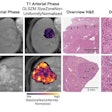Screening MRI may improve survival rates for women with family risk factors for breast cancer. But the technology is expensive, especially for younger women, so finding screening alternatives may be beneficial, according to a new study published online in the Journal of the National Cancer Institute.
Women with a family history of breast cancer are often screened with mammography before they are 50. Adding MRI to the screening protocol improves sensitivity and is cost-effective for those women who carry BRCA mutations, the researchers noted. But whether adding MRI to mammography is cost-effective for women who have a family history of the disease but do not have the gene mutation is unclear, according to lead author Dr. Sepideh Saadatmand, from Erasmus Medical Center in Rotterdam, the Netherlands.
"MRI has been shown to have a higher sensitivity than mammography in screening women with a familial risk for breast cancer, but it is unknown whether this increase in sensitivity is also cost-effective," Saadatmand told AuntMinnie.com via email. "MRI screening is very expensive and causes more false-positive findings, so we wanted to investigate whether the benefits of MRI outweigh the disadvantages for women with just a familial risk, rather than those who also have a genetic risk."
The researchers evaluated the cost-effectiveness of adding yearly MRI scans to the screening schedule for women with a family risk of breast cancer who had participated in the MRI Screening Study (MRISC), a Dutch multicenter trial that compared the efficacy of mammography with MRI for surveillance of women with a hereditary predisposition for breast cancer.
From November 1999 to August 2007, 1,597 women ages 25 to 70 who were categorized as having moderate to high cumulative lifetime risk for breast cancer were screened with a clinical breast examination every six months and with annual mammography and MRI (J Natl Cancer Inst, August 12, 2013).
The team determined the cost per detected and treated breast cancer and used MRISC data with a microsimulation screening analysis (MISCAN) model that calculated the cost-effectiveness of different screening strategies for women with a family history of breast cancer.
Forty-seven breast cancers (nine of which were ductal carcinoma in situ) were detected. The difference in incidence rate or tumor stage and characteristics between the moderate-risk and the high-risk women was not statistically significant, so the researchers assumed that cost-effectiveness calculations were similar and did not separate the two groups.
The team found that screening with additional MRI cost $123,672 per detected breast cancer, while the cost per detected and treated cancer was $133,760.
As women aged, the cost per detected and treated breast cancer decreased -- which the researchers attributed to the higher cancer incidence rate. But the percentage of MRI-only detected cancer also increased as women aged, according to Saadatmand.
"It was surprising that the percentage of MRI-only detected cancers was not higher at a young age, but [instead] increased with rising age," Saadatmand told AuntMinnie.com. "One would expect additional MRI to be most useful in the youngest age categories, since these premenopausal women often have dense breasts, which decreases mammography sensitivity."
With the MISCAN model, Saadatmand and colleagues estimated the effects and costs of screening women with a cumulative lifetime risk for breast cancer of 15% to 50%, using biennial mammography screening from ages 50 to 75 years (which is the protocol of the current Dutch nationwide breast cancer screening program). They then compared this approach to no screening.
The screening protocol would result in an estimated mortality reduction of 37% at a cost of $14,922 per life-year gained, the group found.
Screening under the MRISC protocol (clinical breast examination every six months and annual mammography and MRI from age 35 to 50, followed by biennial mammography until the age of 75) would reduce breast cancer mortality by 25% and cost $134,932 per life-year gained, according to Saadatmand and colleagues. Screening annually with MRI followed by mammography and a clinical breast exam six months later was more efficient under the MRISC protocol because it also reduced breast cancer mortality by 25%, but it decreased costs to $118,936 per life-year gained.
MRI screening decreases mortality rates for women with a familial risk for breast cancer, but there may be other protocols that effect similar survival rates for less, they concluded.
"Screening with additional MRI is expensive, but it can improve survival for women with familial risk for breast cancer," the team wrote. "Still, it may be more cost-effective in select groups."




.fFmgij6Hin.png?auto=compress%2Cformat&fit=crop&h=100&q=70&w=100)




.fFmgij6Hin.png?auto=compress%2Cformat&fit=crop&h=167&q=70&w=250)











